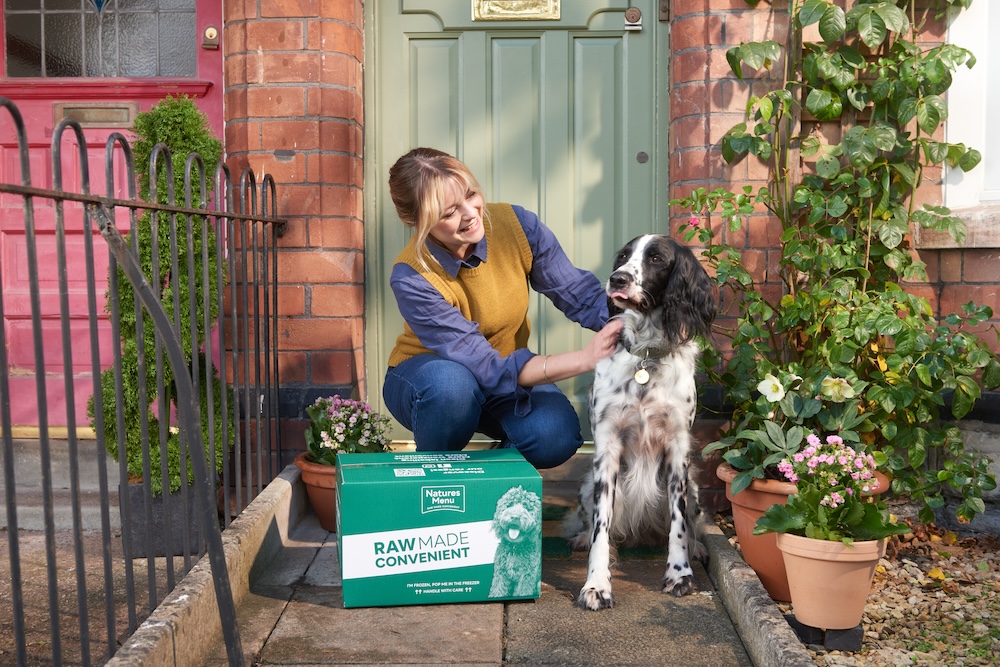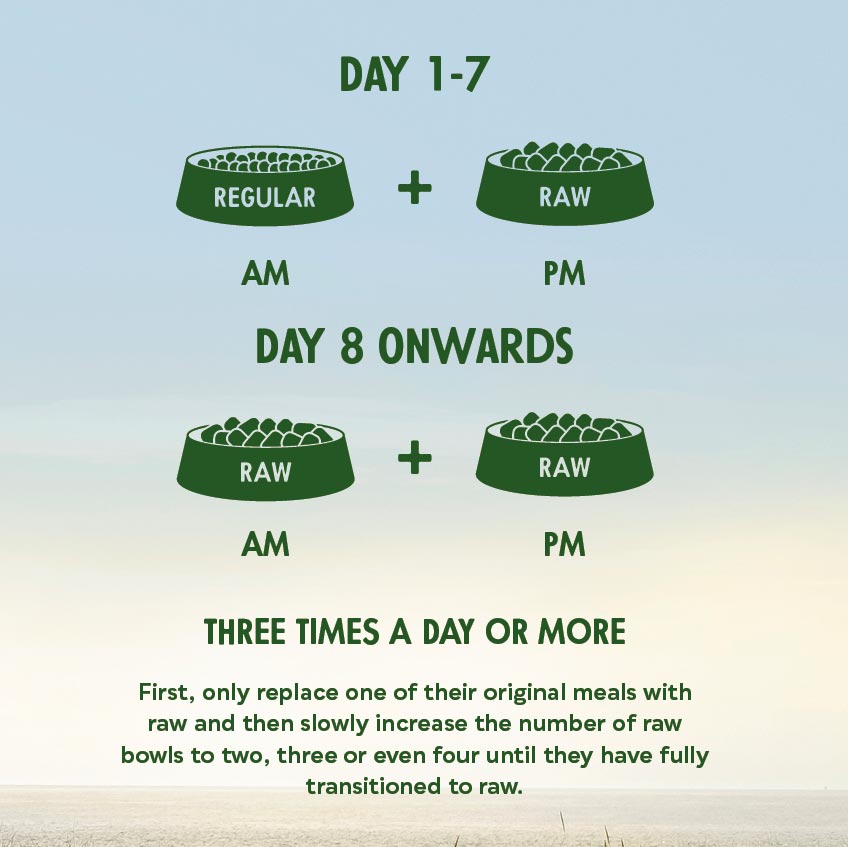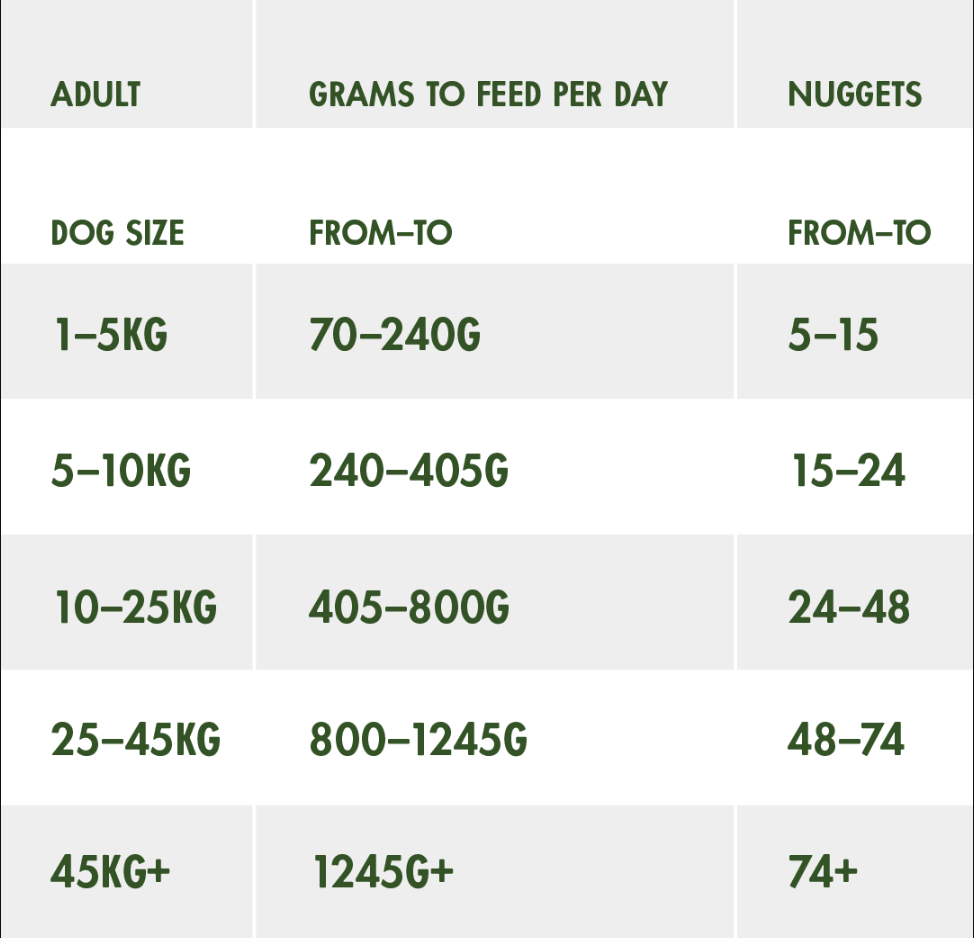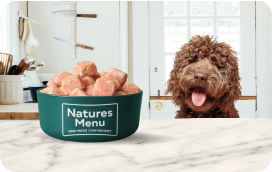Raw feeding is increasing in popularity, and for good reason. Find out everything from the big benefits to the steps for switching

Outline:
Quick takeaways for raw feeding
- A raw diet is suitable for all types of dogs – it's as close as possible to what our dogs would have eaten in the wild.
- Raw food is made from a mix of raw meat, vegetables, fruits – and sometimes carbs like grains.
- Raw food can benefit dogs inside and out from their gut to their coat.
- Making the switch to raw food can feel daunting, but you can do it easily and gradually across 7 days.
Every pet owner knows good nutrition is key to a happy, healthy dog. But, pet food comes in so many varieties that it can be difficult to figure out the best diet for your dog.
And while dogs might not chase down their dinner any more, a high-quality raw food diet closely mimics what your dog's ancestors in the wild would have eaten.
That's one reason more and more owners are choosing raw food for their pets.
The process is a bit different from feeding cans or kibble, but it's very straightforward. With just a few simple steps and with Natures Menu nuggets and meal plans, there's no mess or faff.
So, here's the lowdown on raw feeding for beginners – the potential benefits, the cost, how to serve and how to transition from dry food.
What is raw dog food?
A raw food diet is all about feeding your dog what their ancestors would have naturally eaten in the wild.
While it might not sound appetizing to us humans, dogs are omnivorous, which means they survive on a variety of plants and meat. And a raw food diet goes right back to their roots.
Raw dog food contains a blend of meat – including bones and offal – fruit, and vegetables.
Some recipes also include a small portion of non-starchy carbohydrates. This helps satisfy dogs with bigger appetites and can mimic the natural stomach contents of prey animals, such as rabbits and deer.
A quick raw dog food glossary
Here are some terms that are helpful to know when you're researching raw food:
- BARF – Short for 'Biologically Appropriate Raw Food,' a BARF diet is all about feeding your dog what they would naturally eat in the wild. This can also stand for 'Bones and Raw Food'
- Complete – Food that contains all the nutrients your dog needs without having to add any supplements.
- Balanced – Food with essential nutrients present in the right ratios.
80/20 vs 60/40 formulas
Natures Menu Complete & Balanced 80/20 food contains 80% meat (and offal), and 20% fruits and vegetables. It's also reinforced with superfoods, vitamins and minerals, so you don't need to add anything more.
The Complete & Balanced 60/40 range is made of 60% meat and offal, blended with 40% vegetables and grains, which can be great for all adult dogs.
Check out our personalized meal plans made with high-quality ingredients.
Is raw dog food good for dogs?
Packed with vital nutrients, a high-quality raw diet can quite literally benefit your dog from snout to tail, including:
1. Digestive well-being
A raw food diet can help your dog's digestive well-being, according to recent research published in the Journal of Animal Science .
This leads to small, firm poos that are easier to pick up. Win-win.
2. Oral hygiene
Raw food is free from artificial sugars, colours and preservatives that can build up and cause bad breath and tartar build-up. So, it can support healthy teeth and oral hygiene.
Some owners find that raw bones in particular can help to stave off tartar and keep their dog's gums clean and healthy.
3. Shiny coat
The benefits also shine on the outside with owners consistently reporting glossy, shiny coats and healthy skin.
Are there any cons with raw feeding?
Any kind of pet food has its pros and cons.
Here's what every owner should consider before switching to a raw food diet for dogs:
Adjustment period
While plenty of dogs switch to raw without any trouble, some might need a little time to adjust.
We recommend transitioning your dog across 7 days to help prevent a stomach upset.
Time commitment
Choosing raw food can mean investing more time in prepping your dog's meals.
But our raw nuggets help you save time compared to the traditional method of weighing and mixing your own raw ingredients.
Storage space
Most raw food needs to be kept frozen, so you'll need to set aside some dedicated freezer space for your pooch.
What do vets think?
A vet's priority is always a complete, balanced and safe diet for your dog.
While many dogs thrive on a raw diet, it might not suit dogs with certain health conditions.
Some vets might also caution against raw dog food because of the risks associated with nutritional deficiencies and bacteria, especially when it comes to home-prepared raw food.
But more studies like this by The University of Helsinki have shown that the chance of cross-contamination is very low when served correctly.
“Vets and nurses are trained to be critical, and because raw feeding is a relatively new concept increasing in popularity, the lack of scientific knowledge behind the diet can be a big issue,” says a veterinary nurse and educator for Natures Menu, Melanie Sainsbury.
And, when you feed your dog high-quality raw food, following the instructions of the specific brand, the benefits can shine through.
Is raw food right for your dog?
Dogs of all breeds, ages and lifestyles can eat raw food. You can tailor a meal plan to your dog's needs, whether they're a Chihuahua or Great Dane, young puppy or senior dog.
Dogs of all breeds
Raw isn't just for large breed dogs, it's suitable for small and tiny dogs too.
Natures Menu also makes it easy to measure out portions for small dog breeds.
Senior dogs
As dogs move into their older years, they use less energy than they did in their bouncy puppy years.
Food that's high in good-quality protein can help keep their weight off and energy levels up.
Puppies and youngsters
Dogs can benefit from raw food right as they are lean. Natures Menu also has raw nuggets for puppies to support healthy growth.
Fussy eaters
Raw food comes with big flavor and texture, that even picky dogs love. Plus, you can mix up the proteins to suit fussy eaters – from turkey to beef to duck.
How do you transition to raw dog food?
We know switching to raw food is a transition for both you and your dog. It can seem daunting at first, so here's a step-by-step breakdown.
Introducing raw food to your dog
We recommend a gradual transition period of 7 days for most dogs.
Days 1–7: Feed your dog 2 meals a day. Serve them one meal of their usual food, and the other of raw food. If you can, space the meals out by 12 hours to allow each one to digest.
Day 8+: After the first week, you can feed your dog raw food 100% of the time.

Serving raw dog food
Meal time for your dog takes 3 simple steps.
- Store – Once your raw food arrives, pop it straight into the freezer.
- Defrost – Raw food needs to be thawed either overnight or for a few hours before it's ready to eat.
- Serve – Once defrosted, serve it up within 24 hours. Bon appétit!
How much raw food should I feed my dog?
Dogs have different needs based on how big or small they are and how active they are day to day. Our recommendations are based on the European Pet Food Guidelines.
Our raw dog food calculator (and the chart below) takes your dog's weight into account to work out the optimal amount of food they need.
We've also based our guidelines on the nutritional values of our food. So just a heads up, there may be a slight difference between our numbers and those of a different company.
There may also be a slight difference in feeding amounts between our complete recipes but again, this just takes into account the energy density of each delicious recipe.

How much does raw dog food cost?
Natures Menu meal plans are highly personalized to cater for your dog's unique needs.
The cost will depend on your dog's breed, age, size, activity level and dietary requirements.
But, on average it will cost under £2 a day to feed a medium-sized dog with standard dietary requirements.
How do you make sure raw food is safe?
Natures Menu has 40 years of experience making high-quality raw dog food.
We make our food in DEFRA-approved (Department for Environment, Food & Rural Affairs) facilities and follow FEDIAF guidelines (the European Pet Food Industry) to ensure the safety of your dog and everyone in your family.
From kibble to raw, all dog food has animal origins and comes with some risk of contamination. So, following good hygiene during raw food prep is essential.
We recommend prepping your dog's food away from where you cook your own meals. Give all surfaces, bowls and utensils a good clean and disinfection.
And be sure to wash your hands thoroughly with hot, soapy water.
It's basically about taking the same hygiene precautions as you would when handling raw meat for your own meals.
How can you track your dog's health?
There are some key signs that a raw food diet is working:
- Energy levels – If your dog is sluggish or tired, switching to raw could help them get their bounce back. Some owners have also told us their hyperactive dogs became calmer.
- Shiny coat – Glossy, shiny coats and fresh breath are other signals.
- Smaller poos – You might notice smaller, firmer and even less smelly poos that are easier to handle.
Some owners have also told us their dog's tear ducts stop leaking as much, which can cause 'tear staining' on the fur, just below the eyes.
Others have reported their dog's overall health has improved – from reduced anal gland issues to skin irritations.
What if raw food doesn't work for my dog?
Every dog is different, and some simply don't take to a raw diet.
Natures Menu also has a range of gently cooked wet food that's gently cooked to preserve all the natural goodness.
We've found this works well if you have multiple dogs – so you can still get all your food from one place if one dog likes raw and the other prefers cooked.
Raw dog food for beginners FAQs
Where can I buy raw dog food?
You can order Natures Menu online and our subscription meal plans mean you can always have enough food each month without having to think too much about it.
Or, find us online or in-store at your local Pets At Home .
What can I mix with raw dog food?
While our complete and balanced meals don't need any add-ins, sometimes it's good for your dog to sample a few different foods.
You could add the following foods to their bowl or as treats if you wanted:
- The occasional hard-boiled egg
- Sweet potato
- Carrots
- Green veg such as peas or broccoli
- Berries or bananas
- Freeze-dried meat chunks
What about raw food treats?
We have many treats, which sit alongside a raw diet perfectly – whether you're training a puppy or just rewarding your dog for being good.
From superfood bars and training treats to frozen raw snacks like duck necks and beef trachea – your dog will find our treats irresistible. And as a bonus, you get to feel good about giving your dog a nutritious snack.
The bottom line
Most dogs are well adapted to thrive on a raw, natural diet, and switching to raw dog food can unlock health benefits from healthy digestion to clean teeth.
We know that making a big change can sometimes feel like you've bitten off more than you can chew.
But, with a personalized meal plan subscription, you can leave it to us to make sure you and your dog have exactly what you need, when you need it.
And we'll leave it to you to carry on being a brilliant dog owner.
Try our personalised meal plans with high-quality raw ingredients, to help keep your dog healthy and happy.










